His Majesty King Bhumibol Adulyadej The Great
Chapter 7: The Establishment of International Relations
In the Sukhothai period, Thailand’s relations with foreign countries were rather limited, confined mainly to neighboring territories, and focused largely on trade or occasional warfare.
Thailand began to establish contact with Western nations in the sixteenth century. Portugal was the first European country to trade with Thailand in 1516 (B.E. 2059). This was followed by Spain in 1598 (B.E. 2141), the Netherlands in 1603 (B.E. 2146), and England in 1612 (B.E. 2155), during the reign of King James I of England, which corresponded to the reign of King Ekathotsarot of Ayutthaya. Meanwhile, French missionaries arrived in Ayutthaya around 1664 (B.E. 2207), during the reign of King Louis XIV of France and in the time of King Narai the Great of Thailand.
King Louis sent envoys and delegations to Thailand on three occasions, and Thailand reciprocated by sending diplomatic missions to France three times as well. The third Siamese embassy consisted of Ok Phra Wisut Sunthon (Kosa Pan, who is noted in history as the ancestor of the Chakri Dynasty, as shown in genealogical records) as ambassador, together with Ok Luang Kanlaya Ratchamaitri and Ok Khun Si Wisan Wacha. This mission traveled to France in 1685 (B.E. 2228).
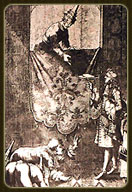
The French ambassador presented the royal letter to King Narai the Great in 1685 (B.E. 2228).
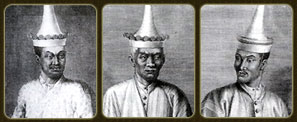
The third Siamese embassy consisted of Ok Phra Visutsunthon (Kosa Pan) as the ambassador, Ok Luang Kanlayarat Maitri, and Ok Khun Siwisanwacha.
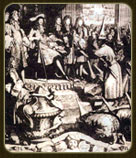
The Siamese diplomatic mission was granted an audience with King Louis XIV in France in 1686 (B.E. 2229).
Ancestral chart of Somdet Phra Pathom Wong

From the book Thamrongsak Ayuwatthana. Chakri Dynasty and the Complete Edition of the Taksin Dynasty (Part One). 2nd edition. Bangkok: Bannakit Trading, 1972. Page 8. After the passing of King Narai the Great, diplomatic relations with foreign countries were suspended for nearly a century and a half, until the reign of King Mongkut, Rama IV of the Chakri Dynasty.
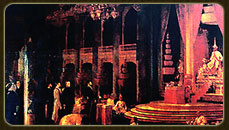
King Mongkut, Rama IV, on the occasion of receiving the French diplomatic mission on 22 November 1867 at the Anantasamakhom Throne Hall within the Phra Abhinav Nivet Palace, wore the Legion of Honour sash along with its star, the French decoration, to honor the French diplomatic mission on that occasion.
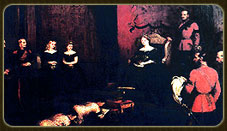
Photograph of the Thai diplomatic mission, in which King Mongkut, Rama IV, graciously commanded the Thai envoys to deliver the royal letter and tribute to Queen Victoria in England.
Thailand concluded a treaty with England when Queen Victoria graciously appointed Sir John Bowring as the ambassador to negotiate a treaty with Thailand concerning trade freedom and consular protection in 1855. This treaty was called the “Bowring Treaty.” In the same year, twelve other countries requested similar treaties with Thailand, including the United States, France, Denmark, Portugal, the Netherlands, Germany, Sweden, Norway, Belgium, Italy, Austria-Hungary, and Spain. King Mongkut graciously appointed the Thai diplomatic mission, consisting of Phraya Mantri Sri Suriya Wong (Chum Bunnag) as ambassador, Mum Sam Pha Phet Phakdi (Pheng) as deputy ambassador, and Mum Mantean Phithak (Duang) as third envoy, with Mom Rachothai (Mom R. W. Kratai Isarakul) serving as interpreter, to deliver the royal letter and tribute and to cultivate royal relations with the English court in 1857.
During the reign of King Chulalongkorn, Rama V, he maintained excellent royal relations with King Oscar II of Sweden and Tsar Nicholas of Russia. Even when he held the title of Crown Prince, Kaiser Wilhelm II of Germany received him as a royal friend.
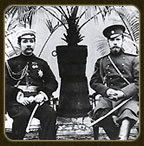
King Chulalongkorn posed for a photograph with Tsar Nicholas.

His Majesty Emperor Kaiser Wilhelm II
His Majesty King Chulalongkorn (Rama V) made two foreign trips: one to visit countries south of Thailand, including Singapore, Batavia (1890), and India (1891), and another to Russia and Europe (1897). In subsequent reigns, Thailand’s monarchs maintained increasingly close relations with foreign nations, including Kings Rama VI, Rama VII, Rama VIII, and the current reign. Members of the royal family in each reign also studied abroad, as did many commoners and descendants of court officials. These experiences helped foreign countries become better acquainted with Thailand, while Thailand welcomed foreigners to serve in the royal court, rewarding their service with honors similar to those given to Thai officials, such as medals and noble titles.
The Cultivation of Diplomatic Relations During the Reign of His Majesty King Bhumibol Adulyadej the Great
In the reign of His Majesty King Bhumibol Adulyadej the Great, after the King had visited the citizens throughout all regions of the country, He set His mind to visit friendly nations to foster international relations, following the example of His Royal Grandfather, King Chulalongkorn, and the previous monarchs.
This is considered one of His most prominent royal duties, and it promoted Thailand to be known to hundreds of millions of people worldwide. He visited foreign countries upon invitations from kings, presidents, and prime ministers of 27 nations across 4 continents, with whom Thailand enjoyed close and friendly relations.
The international visits to 27 countries over 8 years (1959–1967) took place during a period when many countries faced political crises. The results of these visits by His Majesty King Bhumibol Adulyadej and Her Majesty Queen Sirikit, the Queen Mother, brought remarkable benefits to Thailand in political, economic, social, and national security aspects. The effects extended far beyond the reports of each country visited and continued to have long-lasting implications for the future.
In 1959 (B.E. 2502)
Visited South Vietnam from 18 to 21 December 1959.
In 1960 (B.E. 2503)
2. Visited Indonesia from 8 to 16 February 1960
3. Visited Burma from 2 to 5 March 1960
4. Visited the United States of America (first visit) from 14 June to 14 July 1960
5. Visited the United Kingdom from 19 to 23 July 1960
6. Visited Germany from 26 July to 2 August 1960
7. Visited Portugal from 22 to 24 August 1960
8. Visited Switzerland from 29 to 31 August 1960
9. Visited Denmark from 6 to 8 September 1960
10. Visited Norway from 19 to 21 September 1960
11. Visited Sweden from 21 to 24 September 1960
12. Visited Italy from 28 September to 1 October 1960
13. Visited the Vatican (in Italy) on 1 October 1960
14. Visited Belgium from 4 to 6 October 1960
15. Visited France from 11 to 13 October 1960
16. Visited Luxembourg from 17 to 19 October 1960
17. Visited the Netherlands from 23 to 27 October 1960
18. Visited Spain from 3 to 4 November 1960
(Note: Numbers 5–18 are European countries)
In 1962 (B.E. 2505)
19. Visited Pakistan from 11 to 20 March 1962
20. Visited Malaysia from 20 to 23 June 1962
21. Visited New Zealand from 20 to 29 August 1962
22. Visited Australia from 29 August to 6 September 1962
In 1963 (B.E. 2506)
23. Visited Japan from 27 May to 3 June 1963
24. Visited the Republic of China from 5 to 6 June 1963
25. Visited the Philippines from 9 to 13 July 1963
In 1964 (B.E. 2507)
26. Visited Austria (Europe) from 29 September to 5 October 1964
In 1967 (B.E. 2510)
27. Visited Iran from 23 to 27 April 1967
28. Visited Canada from 20 to 23 June 1967
On the visit to Canada in 1967, also visited the United States of America for the second time as a guest of President Lyndon B. Johnson. On the first visit to the USA in 1960, he was a guest of President Dwight D. Eisenhower.
Farewell address to the Thai people on visits to 14 countries:
“People of Thailand, at New Year I informed you that several countries invited me to visit on state affairs. Now it is the time for me and the Queen to travel to those countries. Tomorrow we will depart from Bangkok to the United States first, then proceed to 13 other countries in Europe.
This trip abroad is for state affairs, to perform my duties as Head of State.”
It is well known that in this era, all countries, whether large or small, always depend on one another. One might even say that all nations are like brothers and sisters. Therefore, we should strive to understand each other’s character and maintain goodwill. Normally, relatives visit each other to inquire about each other’s well-being, but for countries, it is difficult for hundreds of thousands or millions of people to visit one another. Hence, this duty is entrusted to the Head of State. When I visit other countries, I will demonstrate to their citizens that the Thai people hold friendly feelings toward them, and I will do my best to let them know Thailand and foster goodwill toward the Thai people. I will be away for about six months. Naturally, one worries about the country, so I would like to advise all of you to devote yourselves to your duties properly and correctly, to remain calm and composed, so that it will benefit both yourselves and our country.” (Phuengjit Supamit, 2004: 139)
Details of foreign visits from 1959–1960 (a period of six months)
1.Visits to countries in Asia
1.1 The Royal Visit to Vietnam
Visited the Republic of Vietnam for 3 days. On the morning of 18 December 1959, His Majesty King Bhumibol Adulyadej (Rama IX) and Her Majesty Queen Sirikit, the Queen Mother, together with royal attendants, arrived at Tan Son Nhat Airport, Saigon, at 11:00 a.m., and were received with full honors by the authorities of the Republic of Vietnam.
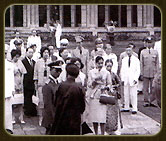
On 19 December 1959, His Majesty received an honorary Doctor of Laws degree, which the Rector of Saigon University conferred. He delivered a royal address expressing confidence in humanity, science, and knowledge as factors that promote individual and national freedom.
On 20 December 1959, He visited Hue University and in response to the Rector’s address, said:
“… Education is a weapon against propaganda aimed at creating division and destruction. It is easy to mislead the uneducated, but those who are intelligent and educated are difficult to deceive …”
On the evening of 21 December 1959, He returned to the capital.
1.2 The Royal visit to Indonesia, arriving in Jakarta.
He also paid respects to the Buddha statue at Borobudur, an ancient Buddhist monument, as well as several other sites, receiving a reception from the Indonesian government and people with full honors.
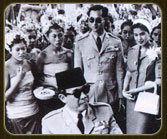
1.3 The Royal Visit to Myanmar
They were warmly received by the President, the government, and the people of Myanmar. Both Their Majesties and the accompanying entourage conducted themselves in a manner highly esteemed by their hosts. For example, when invited by the Myanmar authorities to visit the renowned Shwedagon Pagoda, the President led the visit. Although it is customary for Myanmar citizens to remove their shoes before stepping onto the pagoda platform, this was not specifically instructed to Their Majesties. Nevertheless, King Bhumibol Adulyadej and Queen Sirikit, the Queen Mother, ascended the pagoda barefoot throughout the visit.
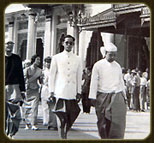
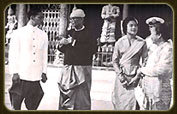
2.The State Visit to the United States of America
His Majesty King Bhumibol Adulyadej graciously appointed Her Royal Highness Princess Srinagarindra, the Princess Mother, as the Regent on His behalf during this state visit to friendly countries.
On 13 June 1960, the King delivered a farewell speech to the people, in part saying:
“… Tomorrow, I will depart from Bangkok to the United States first, and then to 14 other European countries. This visit abroad is a state duty, performed in my capacity as Head of State. Maintaining goodwill is like relatives visiting each other to inquire after well-being, but for countries with hundreds of thousands or millions of people, personal visits are difficult. It is therefore the duty of the Head of State to visit other countries. I will show the people of those nations that the Thai people are friendly toward them, and I will do my utmost to ensure they come to know Thailand and develop good feelings toward the Thai people. I will be away for about six months …”

He visited Mount Auburn Hospital and had his photograph taken with the four doctors and nurses after receiving commemorative gifts.
He visited several states in the United States, including Hawaii, Washington, Williamsburg, Virginia, New York City, Boston, Knoxville, Tennessee, Colorado Springs, and San Francisco, in that order.
The official visit to the United States took place from June 14 to July 14. He delivered a speech at the U.S. Congress in Washington, D.C. on June 29 and 30, and granted interviews to NBC radio and television, emphasizing the need for free nations to cooperate in mutual defense and the importance of foreign investment for Thailand’s economic development in Boston.
On July 7, he visited Harvard University, delivering a speech at a luncheon, and visited Mount Auburn Hospital where he was born. Dr. Victor and the nurses who attended his birth were granted the honor of receiving commemorative gifts, bringing them great joy. In New York City, the royal motorcade passed through streets where it is customary to scatter petals to honor visiting dignitaries.
All roads led to Washington, D.C.
Conferral of Military Rank
The President of the United States, under the authority of an act of Congress dated July 20, 1942, conferred the decoration of the Legion of Merit, Chief Commander grade, upon His Majesty King Bhumibol Adulyadej as Commander-in-Chief of the Royal Thai Armed Forces, in recognition of his outstanding services.
Since ascending the throne on May 5, 1950, His Majesty King Bhumibol Adulyadej, as the Supreme Patriarch and Commander-in-Chief of the Thai Armed Forces, has symbolized unity and steadfast friendship in the free world.
His numerous royal duties naturally required extensive wisdom and insight, particularly in recognizing that the world is fraught with turmoil and destruction caused by wars and the chaotic influence of various ideologies. Efforts to promote freedom must be carried out with diligence and mutual cooperation for the benefit of the nation, for His Majesty, and to preserve the freedom and way of life of the country.
His Majesty the King has been a strong supporter of the Southeast Asia Treaty Organization (SEATO) since its establishment in 1955 and has patronized its continued development. His personal efforts in visiting many countries have had special effects in promoting mutual understanding and closer ties in the nations he visited.
Notably, the significant advancements of His Majesty’s armed forces, resulting from his guidance and leadership, include the high esteem and respect accorded to the Thai military by the United Nations Command in Korea and by all nations in the free world.

The above-mentioned account refers to the presentation of the Legion of Merit, “Chief Commander” class, to His Majesty the King, which President Dwight D. Eisenhower of the United States, on behalf of the American government, conferred during a state dinner at the White House, Washington, D.C., on the evening of 28 June 1960. This represented the highest distinction of honor, recognizing and lauding His Majesty’s exceptional wisdom and leadership by the greatest world power of the time.
During this visit to the United States, His Majesty traveled to nearly all significant locations, particularly to address the joint session of the American Congress. This was an extraordinary milestone in Thai history, marking the first time a Thai monarch received such an official reception at the most important venue of a major world power. His Majesty delivered a speech before the joint session, which contained key messages and left a deep impression on the audience, earning acclaim as “a speech that was applauded 36 times.”
As stated in one of His Majesty’s speeches:
“… Just as in ancient times all roads led to Rome, so today all roads lead to Washington.”
Excerpt from His Majesty’s address to President Eisenhower at Washington Airport on 28 June 1960:
“I wish to thank you, thank you very much, Mr. President. All of us feel honored to have been invited. Before departing for here, I informed my people that this visit is a state affair. When friends or relatives meet, they usually visit one another to maintain friendship. But between nations, it is not so simple. My country has 24 million people, and yours has 190 million. Therefore, as the Head of State of Thailand, I must come on their behalf.
When we departed from Bangkok, the Thai people came to see us off in large numbers, showing their joy and sending their regards. Thus, as the representative of my people, I wish to extend my greetings to you, as the representative of your people, and may you have prosperity and happiness. Our two nations have maintained excellent relations for a long time, owing to shared values. We believe that without freedom, happiness cannot exist. Arriving here, we have observed many similarities. We value simplicity, and most importantly, we cherish freedom.
Personally, this visit is of great significance. I was born in this country, so I can say that the United States is like a second home to me. Visiting here brings great excitement and joy, as if returning home.
Thank you once again, Mr. President. Thank you very much.”
(Pramuanwitthaya, 1971: 75)
(USIS News, June 30, 1960)
3.The Royal Visits to 14 European Countries
In every country visited by His Majesty King Bhumibol Adulyadej (Rama IX) and Her Majesty Queen Sirikit, the Queen Mother, they were warmly received by the heads of state, governments, and citizens. Ceremonial receptions were held upon their arrival, and palaces, municipal halls, or first-class hotels were arranged as venues for honoring and hosting them. His Majesty the King laid wreaths at the Tomb of the Unknown Soldier, paid return visits at the residences of the heads of state, and received ambassadors and government representatives stationed in those countries. Her Majesty the Queen Mother visited hospitals and Red Cross societies, and both of Their Majesties observed various activities in each country, including economic, military, and regional matters, to adapt and apply the knowledge for the benefit of Thailand and its people.
3.1 The Royal Visit to the United Kingdom
Her Majesty Queen Elizabeth II of the United Kingdom, the royal family, the government, and the people gave a very warm welcome. His Majesty the King sent a message of gratitude to Her Majesty Queen Elizabeth II, in which he stated:
“… This visit to the United Kingdom will help bring our two countries and our royal families closer together for mutual benefit. I wish Your Majesty and the Duke of Edinburgh happiness, success, and a long and prosperous reign over the United Kingdom. At the same time, I extend my best wishes to all the people of the United Kingdom for happiness and prosperity throughout the nation.”
Bhumibol R. (Royal Cypher)

Visited the United Kingdom. Her Majesty Queen Elizabeth II of England
Received Them at Victoria Station, London, in 1960 (B.E. 2503).
Her Majesty Queen Elizabeth II wrote a letter in response to His Majesty King Bhumibol Adulyadej, saying:
“… I sincerely thank Your Majesty for the letter that reached me on the occasion of Your Majesty’s departure from the United Kingdom, and for Your Majesty’s kind wishes for Prince Philip, myself, and my people. I am delighted that Your Majesty enjoyed Your stay in London. You and the Queen were most welcome guests. The reception Your Majesty received from the British people will assure Your Majesty of the high regard the British hold for You and for Thailand. The long-standing friendship between our two countries will be strengthened by Your Majesty’s visit to the United Kingdom.”
(Royal Signature) Elizabeth
This is clear evidence that international visits, particularly to the great power of the United Kingdom, were highly successful, as acknowledged by Her Majesty the Queen of England regarding His Majesty’s royal duties on this occasion.
Vilas Maneewat (2000: 153) wrote:
“… At the beginning of 1966, the Duke of Edinburgh of the United Kingdom sent a shallow-draft sailing boat (Catamaran) as a gift.
His Majesty the King named the boat ‘Pla Duk’ [Catfish], which is a play on words. In English, catfish is ‘Cat fish’; ‘cat’ refers to the Catamaran boat, while ‘duk’ clearly echoes the sound of ‘Duke of Edinburgh’ (in Thailand, Prince Philip is commonly referred to simply as ‘Duke’).”
This demonstrates the close relationship between His Majesty the King and Prince Philip, and also highlights His Majesty’s literary ingenuity.
3.2 The Royal Visit to the Federal Republic of Germany
President Lubke and his wife, as well as Dr. Konrad Adenauer, the Chancellor, and his wife, despite their busy schedules, stayed close to accompany Their Majesties throughout the visit.
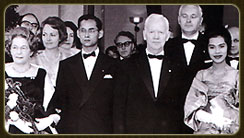
A royal portrait was taken with President Heinrich Lubke of the Federal Republic of Germany in 1966.
On this occasion, the German Prime Minister donated an X-ray machine, and the honorary Thai consul donated a Pfaff sewing machine. The Daimler-Benz Company contributed an ambulance to the Thai Red Cross. The Krupp Company, which trades in Thailand, offered two scholarships for Thai students to study in Germany for one year, covering travel expenses. Siemens provided a one-year scholarship for one student, and Daimler-Benz offered two scholarships for training in their factory.
- 3.3 The Royal Visit to the Portuguese Republic
His Majesty visited the engineering research and testing station.
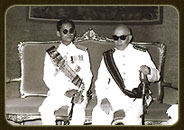
He posed for a royal portrait with the President of Portugal, Americo Rodrigues Tomas, in 1960.
- 3.4 The Royal Visiting Switzerland
He visited military installations and military schools, the Ovaltine factory, and the Omega watch factory.

Visited the Amour Corps Cadets Military Academy in 1960.
3.5 The Royal Visit to the Kingdom of Denmark
Visited the East Asiatic Company, a nuclear energy research institute, and Roskilde Cathedral. The King of Denmark offered to grant a fund to establish the Thai-Danish Dairy Center at Pak Chong. The Danish government graciously approved the Thai-Danish Dairy Farm project in Muak Lek District, Saraburi Province, which was inaugurated on January 6, 1962, with King Frederick IX of Denmark and King Bhumibol Adulyadej as joint patrons.

Held a cordial audience with King Frederick IX and Princess Margrethe of Denmark in 1960.
3.6 The Royal Visiting the Kingdom of Norway
Traveled by the ship Jutlandia from Copenhagen, Denmark, to Oslo. Visited the museum housing ski collections, toured scientific and industrial research institutes, visited the Kontiki harbor, and observed polar exploration ships and Viking ships.

Visited Norway in 1960 (B.E. 2503), welcomed at the Oslo harbor by King Olav V and Princess Astrid.
3.7 The Royal Visit to Sweden
Visited the Naval Officer Training Center, Gripsholm Castle, a factory producing agricultural machinery, and various tools.
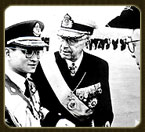
Had an audience with King Gustav Adolf VI of Sweden in 1960.
3.8 The Royal Visit to Italy
He visited a nuclear power plant and watched an equestrian show.

He traveled as a royal guest to the Italian Republic in 1960 (B.E. 2503).
3.9 The Royal Visit to the Vatican
He paid a courtesy visit to offer blessings to Pope John XXIII on October 1, 1960 (B.E. 2503) for 20 minutes. The Pope personally escorted both of Them and the accompanying delegation to the renowned Vatican Library.

Their Majesties during the audience with Pope John XXIII at the Apostolic Palace in the Vatican
3.10 The Royal Visit to Belgium
King Baudouin extended the warmest welcome, and Their Majesties visited the Belgian royal family closely, touring the city and its artistic treasures in nearly every place.
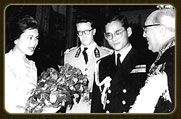
His Majesty delivered a royal address to King Baudouin of Belgium (seated in the center) in 1960.
His Majesty King Rama IX graciously granted permission to the National Museum, Fine Arts Department, to exhibit ancient artifacts abroad on several occasions since 1957. In 1960, Thailand participated in an exhibition in Belgium, where His Majesty personally escorted King Baudouin and Queen Fabiola to view the exhibition.
Wilas Maniwat (2000: 67) recounted the close relationship between King Baudouin of Belgium and His Majesty King Bhumibol as follows:
“… He had deep affection for His Majesty the King. On one occasion, during an official visit to Thailand with Queen Fabiola, he tried several times to persuade His Majesty to convert to Christianity. When His Majesty asked for the reason behind this persuasion, King Baudouin explained that he loved His Majesty deeply and did not wish to be separated from him. He believed this could only be possible if His Majesty embraced Christianity as well, because the Christian faith teaches that believers, after passing away, will dwell eternally in the presence of God. His Majesty did not reject this outright but replied that Buddhism also upholds truth, teaching its followers to realize the truth, which is universal. Whoever follows the right path can reach it. Therefore, if the teachings of Christianity are indeed the ultimate truth and God truly exists, then even as a Buddhist, His Majesty would surely attain it. And if there were anyone standing between Him and God, it would be none other than King Baudouin, who sought to guide Him. This reply greatly pleased the royal guest, sparking his interest in studying Buddhist teachings. Subsequently, His Majesty kindly arranged for English-language Buddhist books to be sent to King Baudouin.”
3.11 The Royal Visit to France
France extended the warmest welcome to His Majesty King Rama IX and Her Majesty the Queen. President Charles de Gaulle, the statesman of the nation, sent the presidential aircraft to bring Their Majesties from Lausanne, Switzerland, to Paris. He also came in person to receive them at the airport, where the royal anthem was played in their honor. His Majesty addressed the Thai people (via Swiss radio), saying, “… I have conversed with the President in a friendly and informal manner, which was pleasing to both sides, and this will certainly help strengthen the good relations between our two countries …”
His Majesty King Rama IX also visited the United Nations Educational, Scientific and Cultural Organization (UNESCO) and toured many renowned and beautiful palaces and castles.
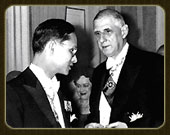
His Majesty delivered a royal address to President Charles de Gaulle of France in 1960.
3.12 The Royal Visit to Luxembourg
This small country saw nearly the entire population come out to pay their respects during the royal visit. His Majesty also toured a steel and iron factory and a hydroelectric dam on the Meuse River in the city of Huy.
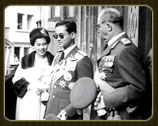
He posed for a royal portrait with Prince Felix of Luxembourg in 1960.
3.13 The Royal Visit to the Netherlands
The Dutch government arranged a special train to receive Their Majesties from Switzerland, arriving in The Hague on October 24, 1960. The visit continued until October 27, 1960. Queen Juliana, King of the Netherlands, and her husband, Prince Bernhard, along with their two daughters, Princess Beatrix and Princess Irene, and the Dutch people extended a warm welcome. Philips, a company with business in Thailand, presented an X-ray machine and an image intensifier to Her Majesty the Queen and also sponsored two Thai students to study science and chemistry for one year. Regarding the Red Cross, the Dutch government donated 500 sets of dried blood to the Thai Red Cross Society.

He posed for a royal portrait with Queen Juliana of the Netherlands, her husband Prince Bernhard, and their daughters Princess Beatrix and Princess Irene in 1960.
3.14 The Royal Visit to Spain
He received a warm welcome from General Franco, the government, and the Spanish people, and toured art institutions, industrial establishments, and several historical sites.

He shook hands with General Francisco Franco of Spain in 1960.
4.The Royal Visits to Friendly Countries in Asia between 1962 and 1967
4.1 The Royal Visit to Pakistan
Upon arrival in Karachi, His Majesty received a warm welcome from the President, the government, and the people. He inspected a naval parade, toured the eyeglass and Dawood textile factories, and visited Peshawar in East Pakistan, where he viewed the Warsak Dam. Peshawar University conferred an honorary doctorate upon His Majesty King Rama IX. He also visited the city of Taxila.

He visited the Badshahi Mosque in 1962.
4.2 The Royal Visit to the Federation of Malaya (now Malaysia)
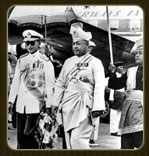
Upon arrival in Kuala Lumpur, His Majesty received a grand welcome from the King (the former ruler of Perlis), the government, and the people of Malaya. He visited the University of Malaya and stayed at Cameron Highlands with the King and Queen of the Federation of Malaya. He also visited Ipoh, Taiping in Perak, various Thai temples across the states, and the city of Penang. His Majesty conferred the “Order of the Crown of Friendship” upon the King of Malaya.
The “Order of the Crown of Friendship,” established in 1962, is awarded to monarchs, presidents, and heads of state of other countries as a mark of honor, treating all foreign heads of state equally. The King of Malaya was the first recipient of this order.
In 1949, Malaya presented the Tilapia mossambica fish to His Majesty, who began raising them in the pond in front of the Udon Throne Hall within Amphon Sathan Hall, marking the first aquatic breeding project of this reign (Kasetsart University, 2001: 29).
4.3 The Royal Visit to New Zealand and Australia
Both countries extended a warm and grand welcome to Their Majesties. In New Zealand, after the official ceremonies and visits in Wellington, Their Majesties traveled to Tauranga and Rotorua, where they observed Maori performances, hot springs, and Maori-style houses in Whakarewarewa. They then visited Hamilton and Auckland, touring the Devonport Naval Base and the Wanganui Air Force Base. Returning to Wellington, they traveled by ship to Christchurch to view the Christchurch Industrial Exhibition at Addington Showgrounds, then proceeded to Dunedin. On August 26, they bid farewell to the Governor-General of New Zealand and spouse, as well as the Prime Minister and spouse, before departing Christchurch Airport for Canberra, the capital of Australia.

He visited New Zealand and the Rotorua Maori Cultural Center in 1962.

The Prime Minister of Australia, Sir Robert Menzies, delivered a welcome address at the official reception banquet in 1960.
In Australia, after the official welcome ceremony at the air force base, Their Majesties stayed at the Government House and visited the Duntroon Military Academy. On August 28–29, they traveled to Sydney, the capital of New South Wales, staying at Government House. They toured Sydney Harbour, the southern coastline, and the iron smelting plant of Australia Iron & Steel Ltd.
On August 31, they traveled from Sydney to Brisbane, Queensland, where they visited the University of Agriculture.
On September 2, they proceeded from Brisbane to Melbourne, Victoria, where the University of Melbourne conferred an honorary doctorate upon His Majesty King Rama IX.
On September 4, Their Majesties visited the botanical gardens and toured the General Motors-Holden factory. Her Majesty the Queen also visited the Australian Red Cross and the Girl Guides training center in Turraburra, Sydney, the Emily McBerlin College of Home Economics, and the Girl Guides Association headquarters in Melbourne.
On September 5, Their Majesties visited Hobart, Tasmania, where they toured a log storage facility and the newspaper paper mill in Maydena.
On September 7, they traveled to Adelaide, South Australia, observing a military parade at Wayville Airport and visiting the headquarters and rocket range at Ireland Lagoon in Woomera.
On September 10, they visited Perth, Western Australia, touring the Swan River by boat and viewing the Commonwealth sports facilities.
4.4 The Royal Visit to Japan
The Emperor of Japan, together with the Empress, members of the imperial family, and officials, welcomed Their Majesties at Tokyo Airport and escorted them to their residence in Tokyo. The Emperor and Empress also accompanied Their Majesties to a concert by the NHK Orchestra, which performed royal compositions. During their stay in Japan, the NHK Orchestra broadcast nearly all of these royal compositions on both radio and television.

He posed for a royal portrait with the Emperor and Empress of Japan.
The following day, May 28, 1963, Prince Takamatsu escorted Their Majesties from the guest reception residence in a procession of six carriages, accompanied by the Imperial Guard, to pay an audience with the Emperor at the Imperial Palace. On this occasion, the Emperor conferred the highest order, the Order of the Chrysanthemum, established by Emperor Meiji in 1887, featuring four chrysanthemum flowers among the leaves, upon His Majesty King Rama IX. He also conferred the First Class of the Order of the Sacred Treasure upon Her Majesty Queen Sirikit. In return, His Majesty King Rama IX presented the “Order of the Crown of Friendship” to the Emperor. That evening, the Emperor and Empress hosted a royal dinner in honor of Their Majesties at the Imperial Palace.
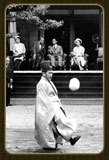
During the royal dinner, the Emperor addressed His Majesty the King, saying:
“… I wish to reaffirm to His Majesty and Her Majesty the Queen of Thailand that we have never forgotten the friendship and goodwill shown during the difficult times we have faced …”
“… I am confident that this visit of Their Majesties to Japan will be a great auspice, promoting mutual understanding and advancing cooperation in all fields. Through this close and friendly relationship, it will contribute to world peace and international understanding …”
His Majesty King Rama IX replied to the Emperor: “As Japan is an industrial nation, Thailand is ready to cooperate with Japan to ensure the economic security of this region and to maintain the good understanding between our two countries for the future.”
On May 30, 1963, His Majesty King Rama IX traveled to Osaka Prefecture, where he toured the Mitsushida Electric Industry factory, visited the Okoin Buddhist temple in Uji, and the Todai-ji Buddhist temple in Nara, as well as Nara Park. He also visited Nippon Lens Company, Mount Hidei, Kawashiba Silk Factory, Roheido Lacquerware Factory in Kyoto, and the Kinkaku-ji Temple.
He then traveled to Nagoya Prefecture, visiting the Chamber of Commerce and Handicrafts and observing cormorant fishing. Upon returning to Tokyo, His Majesty toured the Torii watch factory and the Telefoto service at Goyusaiken Shinkenwa Company.
4.5 The Royal Visit to the Republic of China
On June 5, 1963, His Majesty King Rama IX arrived at Sungshan Airport in Taipei, Republic of China, aboard the royal plane. President Chiang Kai-shek and Madame Chiang Kai-shek welcomed Their Majesties at the airport and escorted them to the Grand Hotel on Taiwan Island. His Majesty observed land reform and rice cultivation twice, programs successfully implemented by the Nationalist government while Thailand was just beginning trials and dissemination.
Later, in 1971, Taiwan sent agricultural expert Mr. Sung to assist at Doi Ang Khang (the Royal Project), and the Taiwan government presented shiitake mushroom cultures and trees as a gift to His Majesty King Rama IX. In 1987, His Majesty graciously conferred the Third Class of the Most Noble Order of the Crown upon Mr. Sung in Lishan.

President Chiang Kai-shek delivered a welcome address at the state dinner at the Presidential Office on June 5, 1963.
Mom Chao Phisadej Ratchanee (1988: 67) recounted about cultivating temperate fruits in Thailand and the role of the Taiwan government as follows:

“… Papa Sung (Mr. Sung) graduated in temperate fruit cultivation in Japan. He believed that our highlands could successfully grow temperate fruits such as apples, peaches, pears, and others. However, other agricultural experts, including Americans, insisted that temperate fruits could not be grown in a tropical country. It turned out that VACRS (the Ministry of Veterans Affairs of Taiwan) and Papa were correct. Papa recounted that when he began the project in Taiwan, the local hill people and his team lived in similar houses. When we visited Papa at Lishan, he maintained his usual lifestyle, but the hill people whose orchards we visited lived in buildings and sent their children to study in the United States. When we were returning to the hotel, they kindly drove us back.
The situation in Thailand was very similar to that in Taiwan … at times it discouraged us. At that time, we thought of Taiwan, which supported and encouraged us as if it were our elder sibling …”
4.6 The Royal Visit to the Republic of the Philippines
Mrs. Diosdado Macapagal, together with officials and the people of the Philippines, accorded a grand welcome to Their Majesties. They stayed at Malacanang Palace in Manila and visited the College of Agriculture of the University of the Philippines at Los Banos, Laguna, which conferred an honorary Doctor of Laws degree upon His Majesty King Rama IX.
Their Majesties also toured the International Rice Research Institute, the birthplace of Dr. Jose Rizal, Nichols Air Base, and Fernando La Union Base. They stayed at the Presidential Summer Palace in Baguio, visited Saint Louis University, a community development project in Sapanto, a famous woodcarving shop, and the Philippine Military Academy at Fort El Pilar, Loaadan.
On September 10, 1963, His Majesty King Rama IX and Her Majesty Queen Sirikit attended the wedding of King Constantine XIII of the Hellenes in Athens, Greece, and visited the Federal Republic of Austria. Later, from September 23–26, 1963, Their Majesties made a private visit to Belgium, where King Baudouin sent a plane to receive and escort them to Geneva, Switzerland.

Mrs. Diosdado Macapagal welcomed Their Majesties at Malacanang Palace.
4.7 The Royal Visit to Austria
ChatGPT said:
Their Majesties visited the headquarters of the International Atomic Energy Agency, attended a special performance at the Spanish Riding School, and watched the opera “Nikaro” at the State Opera. They also traveled to Linz to visit the Voest steel factory and stayed at Klessheim Castle in Salzburg, touring Mozart’s birthplace. Returning to Vienna, they attended a musical performance at the Grosser Musikvereinssaal.
The Vienna Music and Arts Academy conferred an honorary membership upon His Majesty King Rama IX, an honor shared by about ten world-renowned musicians, including Johann Strauss. The Vienna Orchestra performed royal compositions at a charity concert, with opera students singing the composition “Rain Song” and other royal pieces. The audience applauded enthusiastically, honoring both the orchestra and the royal composer.
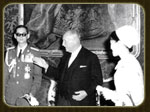
He posed for a royal portrait with the President of the Federal Republic of Austria, Adolf Scharf, in 1964.
4.8 The Royal Visit to Iran
On April 23, 1967, His Majesty King Rama IX and Her Majesty the Queen Mother, accompanied by royal attendants, traveled by royal plane from Don Mueang Airport to Iran. They were accorded a grand welcome by His Majesty Mohammad Reza Pahlavi, the Shah of Iran. Their Majesties toured the treasures of Iran displayed at the National Bank of Iran and visited Isfahan, one of the most beautiful ancient cities in the Middle East, as well as Shiraz and the historically renowned Persepolis.

He received a guard of honor alongside Emperor Shah Mohammed Reza Pahlavi of Iran in 1967.
4.9 The Royal Visit to Canada
On June 20, 1967, His Majesty King Rama IX and Her Majesty the Queen Mother visited Canada, staying at the Government House in Ottawa. They inaugurated Thai Day at Expo 67 in Montreal and then traveled to Quebec City.
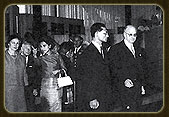
They inaugurated Thai Day at Expo 67.
5.The Royal Visit to the Lao People’s Democratic Republic (1994)
After not traveling abroad for 27 years, in 1994 His Majesty King Rama IX made his first visit to the Lao People’s Democratic Republic. This visit followed a royal request by former President Kaysone Phomvihane (now deceased) to implement the New Theory agricultural project in Laos. On April 8, 1994, Their Majesties visited the Agricultural Development and Service Centers in Na Sai Thong (Station 22), Huai Son, and Huai Sua to officially inaugurate the project offices, following the opening of the historic Lao-Thai Friendship Bridge connecting the two sides of the Mekong River.

On this occasion, His Majesty King Rama IX personally visited the project sites, working directly in the field much as he did in Thailand. He provided guidance to the Thai project team on applying the New Theory, which focuses on land and water management for cultivation, to Laos, noting that the geography of Laos is similar to that of Thailand.
The Thai-Lao project aligns with the concept of globalization. His Majesty King Rama IX repeatedly expressed that “… if neighboring countries are prosperous and development progresses at a comparable level, it will contribute to peace in the region. When each region is stable and complete, it will, in turn, promote world peace as a whole …”
The Royal visit to the royal-initiated projects in the Lao People’s Democratic Republic demonstrated His Majesty King Rama IX’s far-sighted wisdom. He perceived problems and changing global circumstances realistically, responding appropriately to the situation, timing, and opportunity—qualities rarely matched by anyone else. Moreover, His Majesty possessed great benevolence and sincerity in his royal intentions, words, and conduct, as expressed in his remarks to the diplomatic corps on December 6, 1978:
“… If all countries sincerely respect one another and mutually support each other willingly, true understanding will arise. Then peace, freedom, equality, and lasting stability will be established everywhere in the world, just as everyone wishes …”

6.The Benefits of Foreign Visits
His Majesty King Rama IX’s foreign visits brought numerous benefits to Thailand, including:
Promoting Thailand’s reputation and prestige, making the country widely recognized internationally.
Showcasing the honor, distinction, and royal grace of the Thai monarchy to the international community.
Strengthening diplomatic relations between Thailand and other countries, fostering closer and more enduring ties.
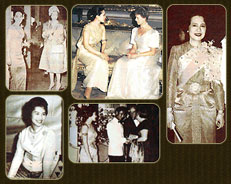
In the case of Her Majesty the Queen Mother, who accompanied His Majesty King Rama IX on his foreign visits, her presence contributed significantly to fostering good relations among women internationally. During these visits, she promoted traditional Thai attire, and today Thai dress and silk are widely recognized and celebrated worldwide as symbols of Thai national identity.
Upon returning to Thailand, heads of state from various countries often paid return visits. Beyond the official receptions, the Queen Mother personally arranged private receptions. Her initiative to showcase authentic Thai performances and cultural demonstrations, each unique for every occasion, was highly appreciated and captivated the foreign dignitaries, reflecting her personal royal vision and cultural diplomacy.
Her Majesty the Queen Mother became widely recognized internationally, with newspapers in Germany, Switzerland, the Netherlands, England, France, the United States, and Japan publishing articles and photographs of her in various activities. This was done to honor her as the Queen of Thailand, admired for her exceptional beauty, representing a population of 33 million people (statistics of 1963), and for her modern and worldly knowledge.
Lady Marcos, wife of President Marcos of the Philippines, who had the idea of establishing the “Asian Cultural Association,” revealed this information while attending Expo ’70 in Japan in June 1970, noting Her Majesty’s widespread international acclaim.

Her Majesty the Queen Mother was invited to become the patron of the “Asian Cultural Association,” following proposals made to the spouses of leaders from various Asian countries.
The association aimed to collaboratively promote arts and culture as a means to foster mutual understanding and to organize cultural exhibitions on a rotating basis among member countries.
Her Majesty took a keen interest in the association and agreed to serve as its patron, as proposed by Lady Marcos. She also suggested expanding the association’s objectives to include her own initiatives: organizing conferences on history, arts, and philosophy, and ensuring the publication and dissemination of Asian literature. Lady Marcos warmly accepted these royal recommendations.
This initiative was a direct outcome of the goodwill and international understanding fostered through the royal visits abroad.
7.Heads of State, Sovereigns, and Royal Families from European, Asian, and Other Countries Visit Thailand
Since His Majesty the King had undertaken royal visits abroad, monarchs, presidents, heads of state, and royal family members from foreign countries have visited Thailand, for example:
7.1 On 27 January 1961, His Majesty went to welcome King Leopold (former) of Belgium and his consort, who visited Thailand privately, at Don Mueang Airport.
7.2 On 16 April 1961, His Majesty went to receive Dr. Sukarno, President of the Republic of Indonesia, who made an official visit to Thailand at Don Mueang Airport, and showed him the scenery along the Chao Phraya River and Chiang Mai Province.

7.3 From 28 to 30 October 1961, His Majesty welcomed President Lyndon B. Johnson of the United States and his wife, who made an official visit to Thailand.
7.4 From 26 to 27 November 1961, His Majesty welcomed Princess Alexandra of Kent, a member of the British royal family, who visited Thailand privately.

7.5 From 8 to 11 December 1961, His Majesty welcomed President Arturo Frondizi of the Republic of Argentina and his spouse, who visited Thailand officially at Chitralada Railway Station. They were accommodated at Phra Thinang Boromphiman in the Grand Palace. His Majesty hosted an honorary dinner at Phra Thinang Chakri Maha Prasat and took them to watch a performance of traditional Thai dance by the Fine Arts Department at Thammasat University Auditorium.

7.6 From 12 to 24 January 1962, His Majesty King Frederick IX of Denmark and Queen Ingrid paid an official visit to Thailand. His Majesty King Bhumibol Adulyadej graciously presided over their royal reception with full honors, welcoming them at Chitralada Railway Station and hosting them at Phra Thinang Boromphiman in the Grand Palace. On 16 January, His Majesty accompanied them to preside over the opening ceremony of the Thai-Danish Dairy Farm and Training Center in Muak Lek District, Saraburi Province.
He led the royal visit to reside temporarily at Phu Phing Ratchaniwet Palace in Chiang Mai Province from January 17 to 23. During this period, he escorted the royal party to various places in Chiang Mai, Phra Nakhon Si Ayutthaya, and Saraburi, as well as on board the Royal Barge Chantra to view certain islands in the Gulf of Thailand. On January 24, he accompanied the royal departure at Don Mueang Airport.
The close and cordial relations between Denmark and Thailand have remained strong, as evidenced by the royal elephant presentation ceremony held in Copenhagen, as follows:
Royal Elephant Presentation Ceremony in Copenhagen (Kingdom of Denmark)
As His Majesty King Rama IX and Her Majesty Queen Sirikit, the Queen Mother, graciously granted permission for Mr. Adisak Phanupong, Ambassador to Copenhagen, to deliver the royal elephants to the Copenhagen Zoo, the Ministry of Foreign Affairs received a report from the Royal Thai Embassy in Copenhagen that the presentation ceremony, held on Friday, 30 November 2001 in Copenhagen, proceeded smoothly and was warmly received by the attendees, the Danish media, and the Danish public. At 12:00 noon on 30 November 2001, His Royal Highness Prince Henrik, the Consort of Her Majesty the Queen of Denmark, arrived at the Old Giraffe House, where the two royal elephants were being housed (while the zoo was in the process of constructing a new permanent elephant house). He was received by Mr. Ole Andresen, Chairman of the Board of the Zoo, and Mr. Lars Lunding Andersen, Executive Director of the Zoo, who reported on the history of the royal elephants previously presented to the Copenhagen Zoo by His Majesty King Rama IX on the occasion of the official visit to Thailand by King Frederik IX of Denmark and Queen Ingrid in 1962.
Subsequently, the Ambassador delivered a report on His Majesty King Rama IX’s gracious command appointing him to present the royal elephants, as well as on the close ties between the royal families of the two countries, and the significance and bond that the Thai people have had with elephants since ancient times. The royal elephants were then presented to Prince Henrik, the Consort, in his capacity as Patron of the Copenhagen Zoo. Prince Henrik, in reply, expressed gratitude on behalf of the zoo and conveyed that both Her Majesty the Queen and he were deeply appreciative of the royal generosity of His Majesty King Rama IX and Her Majesty Queen Sirikit, the Queen Mother, in graciously presenting two elephants to the Copenhagen Zoo. He further requested that the Ambassador convey this message of gratitude to Their Majesties and declared that the royal elephants would be placed under the care of the Copenhagen Zoo.
After the royal elephant presentation ceremony concluded, the Copenhagen Zoo arranged the presentation of a third elephant to the people of Copenhagen on behalf of the people of Surin Province. The Governor of Surin, Mr. Kasemsak Saenphoch, presented the elephant to the Executive Director of the Copenhagen Zoo, who, in turn, expressed gratitude to the people of Surin on behalf of the citizens of Copenhagen. (Public Relations Division, Department of Information, Ministry of Foreign Affairs. 7 December 2001)
7.7 From 14 to 18 February 1963, His Majesty graciously received Their Majesties King Paul I of the Hellenes, Queen Frederica, and Princess Irene of Greece on their official visit to Thailand.
7.8 From 22 to 25 March 1963, His Majesty graciously received His Majesty King Savang Vatthana of the Kingdom of Laos on his official visit to Thailand.
King Savang Vatthana of Laos delivered remarks in response to the Mayor of Bangkok, Dr. Chamnarn Yuvaboon, who presented him with a golden key at the Phanfah Reception Hall, in the presence of His Majesty King Rama IX and the Prime Minister, Field Marshal Sarit Thanarat, stating:
“I wish to express my gratitude for the warm welcome extended by the Thai people, who are true friends of the Lao people. Laos and Thailand will continue to grow ever closer in friendship with each passing day.
We are bound together by blood, kinship through race and religion, and moreover, we share the same river whose flowing waters can never divide us until the end of time.”
King Savang Vatthana had previously visited Thailand for the first time as Crown Prince from 20 to 25 July 1955, accompanied by Queen Khamphoui and their daughter, Princess Manivanh.
7.9 From 15 to 22 October 1963, His Majesty graciously received Her Majesty Queen Juliana and Prince Bernhard of the Netherlands, together with Princess Beatrix, on their official visit to Thailand.
7.10 On 18 November 1963, His Majesty graciously hosted a private luncheon for Her Royal Highness Princess Margrethe, Crown Princess of Denmark, on the occasion of her visit to Thailand at Bang Pa-In Palace.
7.11 From 16 to 21 November 1963, His Majesty welcomed Her Royal Highness Princess Beatrix, Crown Princess of the Netherlands, on her official visit to Thailand. She was accommodated at the Boromphiman Hall in the Grand Palace, and His Majesty graciously escorted her to various sites in Bangkok, Nakhon Pathom, and Kanchanaburi, as well as on a boat trip along the Chao Phraya River to view the scenery.
7.12 From 21 to 26 November 1963, His Majesty welcomed President Heinrich Lubke of the Federal Republic of Germany and Frau Wilhelmine Lubke on their official visit to Thailand. At first, they were accommodated at the Boromphiman Hall in the Grand Palace, after which His Majesty led them to reside at Phu Phing Ratchaniwet Palace in Chiang Mai. His Majesty also graciously arranged for the President and his wife to visit various sites in both Bangkok and Chiang Mai.
Prior to President Lubke and his wife’s visit to Thailand, the Fine Arts Department had received royal permission to send certain Thai antiquities for exhibition in Cologne, Federal Republic of Germany. President Lubke subsequently conveyed a message of gratitude for the royal benevolence of His Majesty the King as follows:
President of the Federal Republic of Germany (The King and Museums, 1996: 104)
Bonn
1 March 1963
Your Majesty,
I am deeply honored to have joined with Your Majesty as patron of the exhibition “Art Treasures from Thailand,” which opened in Cologne on 5 February of this year. This exhibition, excellently curated from the most exquisite works of art from Your Majesty’s country, has been a resounding success, as confirmed from every quarter. I am confident that this exhibition of Thai art will be warmly received in other cities of Germany as well.
The German people and I wish to express our heartfelt gratitude to Your Majesty, and to extend our thanks to all the Thai officials who contributed to the organization of this exhibition of Thai art.
I have also enclosed the English translation of the address I delivered at the opening ceremony. In that speech, I sought to convey how closely and warmly we are connected with the Thai people, and how deeply we admire Thai culture. In preparing those remarks, I was filled with joyful memories of my own most delightful visit to Your Majesty’s beautiful country.
My wife and I send to Your Majesty and Her Majesty the Queen our warmest personal regards and remembrance in friendship.
(Signed) Lubke
7.13 On 22 November 1963, His Majesty welcomed President Sukarno of the Republic of Indonesia.
7.14 From 14 to 21 December 1963, His Majesty welcomed General Ne Win, Chairman of the Revolutionary Council of the Union of Burma, on his official visit to Thailand. He was initially accommodated at Boromphiman Hall, where His Majesty graciously arranged a performance of traditional dance in his honor. His Majesty also took him on a royal barge trip along the Chao Phraya River and invited him to stay at the government guesthouse at Samsuk, Bang Saen.
7.15 From 10 to 14 January 1964, His Majesty welcomed Princess Ashraf Pahlavi of Iran and her consort on their private visit to Thailand.
7.16 From 3 to 7 February 1964, His Majesty graciously received His Majesty King Baudouin and Her Majesty the Queen of Belgium on their official visit to Thailand. They were accorded full royal honors in Bangkok and were later escorted to reside at Phu Phing Ratchaniwet Palace in Chiang Mai Province.
7.17 From 24 February to 3 March 1964, His Majesty welcomed His Majesty King Yang Di-Pertuan Agong and Her Majesty the Queen of Malaysia on their official visit to Thailand.
7.18 From 15 to 19 April 1964, His Majesty welcomed Princess Shams Pahlavi of Iran and her consort on their private visit to Thailand.
7.19 From 15 to 23 January 1965, His Majesty received His Majesty King Olaf V of Norway on his official visit to Thailand, both in Bangkok and Chiang Mai Province.
7.20 From 2 to 10 February 1965, His Majesty welcomed Prince Bertil of Sweden on his official visit to Chiang Mai Province, Thailand.
7.21 On 21 February 1965, His Majesty went out to receive Prince George and Princess Anne of Denmark during their visit to Thailand at Chitralada Royal Palace.
7.22 On 6 March 1965, His Majesty went out to receive Prince Philip, Duke of Edinburgh, on his visit to Thailand.
7.23 On 20 August 1965, His Majesty welcomed General Nguyễn Cao Kỳ, Prime Minister of the Republic of Vietnam, on his official visit to Thailand.
7.24 On 21 September 1965, His Majesty went out to receive Prince Otto von Habsburg and his consort during their visit to Thailand at Chitralada Royal Palace.
7.25 From 8 to 9 October 1965, His Majesty welcomed Prince William of Gloucester on his private visit to Thailand.
7.26 On 28 October 1965, His Majesty escorted Crown Prince Harald of Norway on a royal barge trip along the Chao Phraya River to view the scenery.
7.27 From 14 to 21 December 1965, His Majesty welcomed Crown Prince Akihito of Japan and Princess Michiko, his consort (now Emperor and Empress of Japan), on their official visit to Thailand. His Majesty escorted them to various sites in Bangkok and later to reside in Chiang Mai Province. On this visit, after returning to Japan, Crown Prince Akihito sent fifty Nile tilapia to His Majesty the King on 25 March 1965. His Majesty graciously released them into a cement pond within the Chitralada Gardens of Dusit Palace as part of the royal fisheries project. Subsequently, the fry were granted to the Department of Fisheries for propagation and distribution to the people nationwide. The fish, scientifically named Oreochromis niloticus (Nile tilapia), have become widely consumed throughout the country.
The Japanese royal family has visited Thailand several times as follows:
June 1971: Crown Prince Akihito and Princess Michiko visited Thailand on a private visit as personal royal guests. They visited again on 8–9 June 1976.
20–29 December 1980: Prince Naruhito, son of Crown Prince Akihito and Princess Michiko, visited Thailand and returned for another visit on 10–11 March 1987.
27–28 February 1982, Crown Prince Akihito and Princess Michiko of Japan visited Thailand on a private visit as personal royal guests, and they visited again in 1983.
Prince Fumihito, Ayanomiya (the second son of Crown Prince Akihito and Princess Michiko of Japan) also visited Thailand on several private occasions: 14–24 August 1985, 20–23 August 1986, August 1987, and 17–18 July 1989. He later attended the royal cremation ceremony of Her Royal Highness Princess Srinagarindra, the Princess Mother, in 1996.
7.28 From 27 September to 2 October 1969, His Majesty welcomed Princess Alexandra of Kent of the British Royal Family as a personal royal guest.
Up to 2004, members of European royal families, the Japanese imperial family, the President of the United States, the President of the People’s Republic of China, and others have continuously visited and paid respects to His Majesty the King and the royal family. For example, in 1988–1989, the King of Brunei, the King and Queen of Malaysia, the Prime Minister of Australia, the King of Sweden, and King Norodom Sihanouk of Cambodia visited Thailand either as personal royal guests or on official state visits.
In 1988–1989
The King of Brunei, the King and Queen of Malaysia, the Prime Minister of Australia, the King of Sweden, and King Norodom Sihanouk of Cambodia visited Thailand either as personal royal guests or on official state visits.
In 1996
In October 1996, Her Majesty Queen Elizabeth II of the United Kingdom, together with Prince Philip, Duke of Edinburgh, made another official visit to Thailand. Her Royal Highness Princess Maha Chakri Sirindhorn and Her Royal Highness Princess Chulabhorn Walailak escorted Them to visit the Phu Phan Development Study Center project in Sakon Nakhon Province (Chaipattana Foundation, December 1996: 30–35).
In addition, Prince Hitachi (the younger brother of Emperor Hirohito) of Japan and his consort, as well as President Bill Clinton of the United States and his wife, also visited Thailand during this period.


President Bill Clinton and Mrs. Hillary Clinton made an official visit to Thailand.
8.His Majesty King Bhumibol Adulyadej strengthened Thai–Chinese relations
(Office of the University, The Genius Monarch, 1996: 491–492)

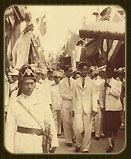
Visit to Sampeng, 1946
The royal visit to Sampeng in 1946 likely left a lasting impression on His Majesty the King, who at that time held the title of Prince Anuchatr. Upon ascending the throne as King Rama IX on 9 June 1946, He became a protective and benevolent presence for all His subjects, particularly the Chinese community in Thailand. His Majesty consistently extended His compassion, even toward the motherland of the Chinese people, China.
When Thailand and China reestablished diplomatic relations on 1 July 1975, they continued to engage in various cooperative exchanges. Notably, cultural and academic exchanges between educational institutions—both public and private—have flourished. These initiatives included collaborations between Thai universities such as Chulalongkorn University, Thammasat University, and Payap University, and Chinese institutions including universities and ethnic minority groups in Yunnan Province, fostering widespread cultural awareness and mutual understanding.
This relationship was further strengthened when President Li Xiannian visited Thailand as a personal royal guest on 11 March 1985.
A memorable moment highlighting Thai–Chinese friendship occurred during that visit, when His Majesty the King personally assisted the 70-year-old President down from the airplane in Chiang Mai. His Majesty’s gentle conduct, as if attending to a close elder relative, left a lasting impression on all who witnessed it, reflecting a deeply ingrained Eastern cultural value of respect and care for the elderly. Moreover, His Majesty’s remarks at the state banquet held in honor of the President, which are cited here as auspicious guidance, demonstrated His benevolent and reasoned regard for the Chinese people and China:
“… The Kingdom of Thailand and the People’s Republic of China are both independent nations, each rapidly advancing toward prosperity according to their own goals and directions. It is therefore essential to respect each other’s sovereignty strictly, while striving to promote friendship and peaceful coexistence with mutual understanding and sincere cooperation …”
In response, the President said:
“… China and Thailand are neighboring countries, and the peoples of both nations have maintained friendly exchanges for over two thousand years. The longstanding friendship between our peoples has developed further over the past ten years. Bilateral relations and cooperation have advanced across political, economic, cultural, scientific, and technological fields …” (Two Hundred Years of Chinese in Thailand, [n.d.]: 29).
Through these efforts, His Majesty the King played a pivotal role in fostering Thai–Chinese relations, beginning from an understanding of everyday life in Sampeng, extending to cultural appreciation, and culminating in diplomatic cooperation.
Ultimately, in the economic sphere as well, it cannot be denied that His Majesty played a crucial role in fostering enduring goodwill between the Thai and Chinese peoples, and in strengthening relations between Thailand and the People’s Republic of China. This achievement was not limited to His Majesty alone; royal permission was granted for senior members of the royal family to participate in these efforts. For example, Her Royal Highness Princess Maha Chakri Sirindhorn and His Royal Highness Crown Prince Vajiralongkorn visited the Chinese community in Yaowarat on 20 March and 20 April 1982, respectively, following in His Majesty’s footsteps on the occasion of Bangkok’s 200th anniversary as the capital. During these visits, the Chinese community had the opportunity to witness closely the presence and benevolence of Tai Zi (Crown Prince Vajiralongkorn) and Gong Zhu (Princess Maha Chakri Sirindhorn).
Moreover, His Majesty graciously authorized the Crown Prince, Princess Maha Chakri Sirindhorn, Her Royal Highness Princess Galyani Vadhana, Krom Luang Naradhiwas Rajanagarindra, and Her Royal Highness Princess Chulabhorn Walailak to visit the People’s Republic of China as official representatives of Thailand to further strengthen bilateral relations. In particular, Princess Maha Chakri Sirindhorn authored Yam Dan Mangkor and Mung Klai Nai Roi Sai in Thai, which were subsequently translated into Chinese. Her Royal Highness Princess Galyani Vadhana also authored Mao Lo Thuk Kwa. These works have helped to bind the hearts of the peoples of both nations even closer together.
In Yam Dan Mangkor, Princess Maha Chakri Sirindhorn recounts adapting to unfamiliar experiences during her visit, as arranged by the Chinese government, including sampling gecko soup, a delicacy in China:
“… Eating something unusual is part of fostering friendship. We have been trained that every overseas visit is official business, not leisure travel. Therefore, we do not have the right to refuse or choose what to do; it depends on the host. Our duty is to represent our country, bringing the good wishes of the Thai people to the host nation and conveying the host nation’s intentions back to Thailand, as well as to discuss and exchange knowledge and cooperation wherever possible …” (Wilas Maneewat, 2000: 47).
When His Majesty the King celebrated his 60th birthday in 1987, the Chinese government, together with the Thai people, participated in the construction of Suan Luang Rama IX to honor His Majesty. Skilled artisans from China were sent to build a Chinese-style pavilion in Suan Luang Rama IX, completing the construction within 30 days (for details, see Chapter 19, “Suan Luang Rama IX”).
9. King of Nepal
On one occasion, the King of Nepal visited Thailand. His Majesty the King showed great kindness toward the Nepalese people. As Suwicha notes in Royal Anecdotes (1996: 139), His Majesty conveyed to the author’s family:
“… The visit of the King of Nepal not only strengthened our friendly relations but also brought mutual benefits. For example, Nepal has many fish species that are at risk of extinction, possibly because they lack advanced fishing techniques. They sent people here to learn, and since we have expertise in fishing—whether in saltwater, brackish water, or freshwater—we are extending academic support and will also send fish species to them …”
“… Another matter concerns wildlife. Rhinos are becoming extinct in Thailand. Nepal has many rhinos, but we did not dare to request them because of their value. The Nepalese King asked if we wanted them; we agreed, and so we received rhinos from Nepal. They will be placed in Phu Khiao Wildlife Sanctuary, Chaiyaphum Province, near Chulabhorn Dam. Later, we will propagate them further until the forest is full. Forests are something we must conserve, as they are part of Thailand’s unique heritage … When wildlife populations increase, we may develop safari parks, accommodation, and eventually tourism. This is a long-term project that will take many years …”
10.His Majesty’s Compassion Toward Somalia
In addition to showing kindness to the Thai people, His Majesty the King extended His compassion to foreigners seeking His royal benevolence. His Majesty demonstrated great generosity when Somalia faced severe famine, graciously ordering the shipment of rice to assist the country, as Suwicha (1996: 159) recounts in Tawan Song Lao.

“… Our fleet was assigned a very important mission, which was to transport 500 tons of rice to Somalia according to the royal initiative of His Majesty the King …”
His Majesty the King conceived the royal initiative for the Thai government to send rice to assist the people of Somalia, who were facing severe famine—approximately 2 million people were in critical need, and another 4 million were beginning to experience food shortages—through the World Food Programme. In addition, the Thai Red Cross contributed 200 tons of rice via the International Committee to aid Somalia. The Thai government entrusted the Royal Thai Navy with the task of delivering the rice.
All Thai people felt deep pride and joy to be born under the benevolent reign of His Majesty King Bhumibol Adulyadej. Organizations and foreign observers alike praised His Majesty’s virtue and merit, which did not arise from the whims of any deity but from His exemplary conduct and a heart overflowing with compassion—extended without distinction of social class or ethnicity. As one observer remarked, “He is truly a wonder.”

